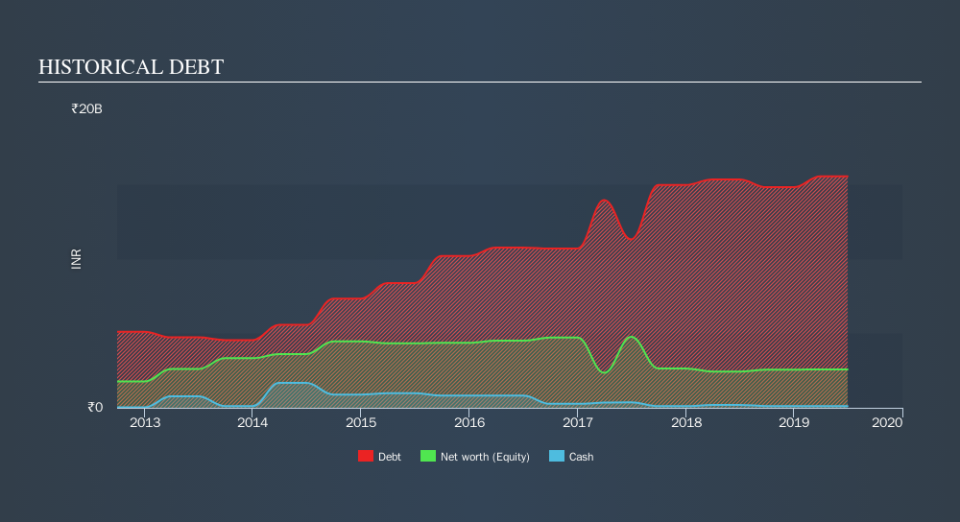Is Emami Paper Mills (NSE:EMAMIPAP) A Risky Investment?

David Iben put it well when he said, 'Volatility is not a risk we care about. What we care about is avoiding the permanent loss of capital. When we think about how risky a company is, we always like to look at its use of debt, since debt overload can lead to ruin. As with many other companies Emami Paper Mills Limited (NSE:EMAMIPAP) makes use of debt. But the real question is whether this debt is making the company risky.
What Risk Does Debt Bring?
Debt and other liabilities become risky for a business when it cannot easily fulfill those obligations, either with free cash flow or by raising capital at an attractive price. In the worst case scenario, a company can go bankrupt if it cannot pay its creditors. However, a more usual (but still expensive) situation is where a company must dilute shareholders at a cheap share price simply to get debt under control. Having said that, the most common situation is where a company manages its debt reasonably well - and to its own advantage. When we think about a company's use of debt, we first look at cash and debt together.
See our latest analysis for Emami Paper Mills
What Is Emami Paper Mills's Debt?
The chart below, which you can click on for greater detail, shows that Emami Paper Mills had ₹15.5b in debt in March 2019; about the same as the year before. Net debt is about the same, since the it doesn't have much cash.
How Strong Is Emami Paper Mills's Balance Sheet?
Zooming in on the latest balance sheet data, we can see that Emami Paper Mills had liabilities of ₹8.74b due within 12 months and liabilities of ₹9.79b due beyond that. On the other hand, it had cash of ₹119.2m and ₹2.69b worth of receivables due within a year. So its liabilities outweigh the sum of its cash and (near-term) receivables by ₹15.7b.
This deficit casts a shadow over the ₹5.87b company, like a colossus towering over mere mortals. So we definitely think shareholders need to watch this one closely. At the end of the day, Emami Paper Mills would probably need a major re-capitalization if its creditors were to demand repayment.
We use two main ratios to inform us about debt levels relative to earnings. The first is net debt divided by earnings before interest, tax, depreciation, and amortization (EBITDA), while the second is how many times its earnings before interest and tax (EBIT) covers its interest expense (or its interest cover, for short). This way, we consider both the absolute quantum of the debt, as well as the interest rates paid on it.
Emami Paper Mills shareholders face the double whammy of a high net debt to EBITDA ratio (6.6), and fairly weak interest coverage, since EBIT is just 1.7 times the interest expense. The debt burden here is substantial. However, one redeeming factor is that Emami Paper Mills grew its EBIT at 12% over the last 12 months, boosting its ability to handle its debt. The balance sheet is clearly the area to focus on when you are analysing debt. But it is Emami Paper Mills's earnings that will influence how the balance sheet holds up in the future. So if you're keen to discover more about its earnings, it might be worth checking out this graph of its long term earnings trend.
Finally, while the tax-man may adore accounting profits, lenders only accept cold hard cash. So it's worth checking how much of that EBIT is backed by free cash flow. In the last three years, Emami Paper Mills created free cash flow amounting to 8.2% of its EBIT, an uninspiring performance. For us, cash conversion that low sparks a little paranoia about is ability to extinguish debt.
Our View
To be frank both Emami Paper Mills's net debt to EBITDA and its track record of staying on top of its total liabilities make us rather uncomfortable with its debt levels. But at least it's pretty decent at growing its EBIT; that's encouraging. Taking into account all the aforementioned factors, it looks like Emami Paper Mills has too much debt. That sort of riskiness is ok for some, but it certainly doesn't float our boat. Above most other metrics, we think its important to track how fast earnings per share is growing, if at all. If you've also come to that realization, you're in luck, because today you can view this interactive graph of Emami Paper Mills's earnings per share history for free.
At the end of the day, it's often better to focus on companies that are free from net debt. You can access our special list of such companies (all with a track record of profit growth). It's free.
We aim to bring you long-term focused research analysis driven by fundamental data. Note that our analysis may not factor in the latest price-sensitive company announcements or qualitative material.
If you spot an error that warrants correction, please contact the editor at editorial-team@simplywallst.com. This article by Simply Wall St is general in nature. It does not constitute a recommendation to buy or sell any stock, and does not take account of your objectives, or your financial situation. Simply Wall St has no position in the stocks mentioned. Thank you for reading.

